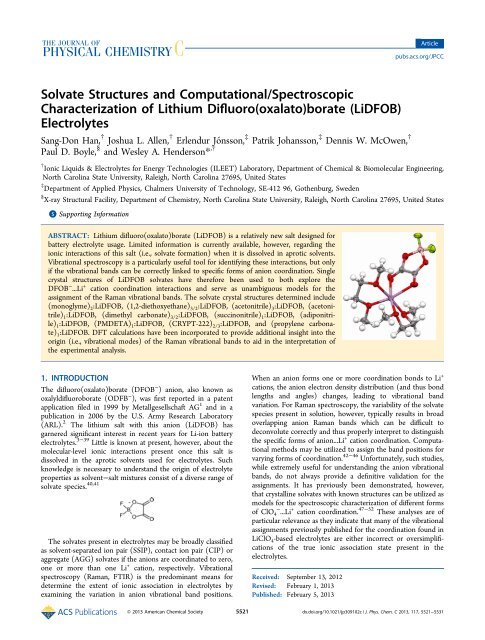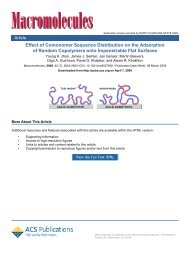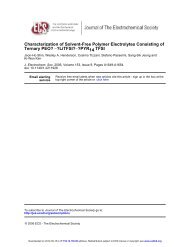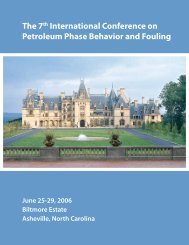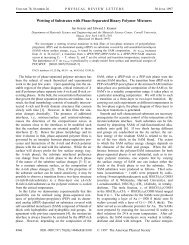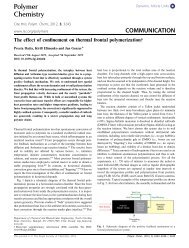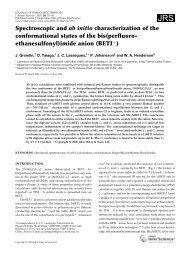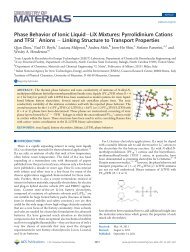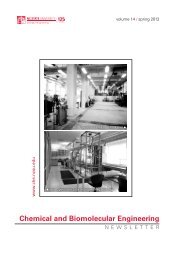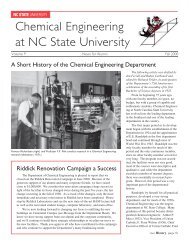LiDFOB - Chemical & Biomolecular Engineering - North Carolina ...
LiDFOB - Chemical & Biomolecular Engineering - North Carolina ...
LiDFOB - Chemical & Biomolecular Engineering - North Carolina ...
Create successful ePaper yourself
Turn your PDF publications into a flip-book with our unique Google optimized e-Paper software.
Article<br />
pubs.acs.org/JPCC<br />
Solvate Structures and Computational/Spectroscopic<br />
Characterization of Lithium Difluoro(oxalato)borate (<strong>LiDFOB</strong>)<br />
Electrolytes<br />
Sang-Don Han, † Joshua L. Allen, † Erlendur Jońsson, ‡ Patrik Johansson, ‡ Dennis W. McOwen, †<br />
Paul D. Boyle, § and Wesley A. Henderson* ,†<br />
† Ionic Liquids & Electrolytes for Energy Technologies (ILEET) Laboratory, Department of <strong>Chemical</strong> & <strong>Biomolecular</strong> <strong>Engineering</strong>,<br />
<strong>North</strong> <strong>Carolina</strong> State University, Raleigh, <strong>North</strong> <strong>Carolina</strong> 27695, United States<br />
‡ Department of Applied Physics, Chalmers University of Technology, SE-412 96, Gothenburg, Sweden<br />
§ X-ray Structural Facility, Department of Chemistry, <strong>North</strong> <strong>Carolina</strong> State University, Raleigh, <strong>North</strong> <strong>Carolina</strong> 27695, United States<br />
*S Supporting Information<br />
ABSTRACT: Lithium difluoro(oxalato)borate (<strong>LiDFOB</strong>) is a relatively new salt designed for<br />
battery electrolyte usage. Limited information is currently available, however, regarding the<br />
ionic interactions of this salt (i.e., solvate formation) when it is dissolved in aprotic solvents.<br />
Vibrational spectroscopy is a particularly useful tool for identifying these interactions, but only<br />
if the vibrational bands can be correctly linked to specific forms of anion coordination. Single<br />
crystal structures of <strong>LiDFOB</strong> solvates have therefore been used to both explore the<br />
DFOB − ...Li + cation coordination interactions and serve as unambiguous models for the<br />
assignment of the Raman vibrational bands. The solvate crystal structures determined include<br />
(monoglyme) 2 :<strong>LiDFOB</strong>, (1,2-diethoxyethane) 3/2 :<strong>LiDFOB</strong>, (acetonitrile) 3 :<strong>LiDFOB</strong>, (acetonitrile)<br />
1 :<strong>LiDFOB</strong>, (dimethyl carbonate) 3/2 :<strong>LiDFOB</strong>, (succinonitrile) 1 :<strong>LiDFOB</strong>, (adiponitrile)<br />
1 :<strong>LiDFOB</strong>, (PMDETA) 1 :<strong>LiDFOB</strong>, (CRYPT-222) 2/3 :<strong>LiDFOB</strong>, and (propylene carbonate)<br />
1 :<strong>LiDFOB</strong>. DFT calculations have been incorporated to provide additional insight into the<br />
origin (i.e., vibrational modes) of the Raman vibrational bands to aid in the interpretation of<br />
the experimental analysis.<br />
1. INTRODUCTION<br />
The difluoro(oxalato)borate (DFOB − ) anion, also known as<br />
oxalyldifluoroborate (ODFB − ), was first reported in a patent<br />
application filed in 1999 by Metallgesellschaft AG 1 and in a<br />
publication in 2006 by the U.S. Army Research Laboratory<br />
(ARL). 2 The lithium salt with this anion (<strong>LiDFOB</strong>) has<br />
garnered significant interest in recent years for Li-ion battery<br />
electrolytes. 3−39 Little is known at present, however, about the<br />
molecular-level ionic interactions present once this salt is<br />
dissolved in the aprotic solvents used for electrolytes. Such<br />
knowledge is necessary to understand the origin of electrolyte<br />
properties as solvent−salt mixtures consist of a diverse range of<br />
solvate species. 40,41<br />
The solvates present in electrolytes may be broadly classified<br />
as solvent-separated ion pair (SSIP), contact ion pair (CIP) or<br />
aggregate (AGG) solvates if the anions are coordinated to zero,<br />
one or more than one Li + cation, respectively. Vibrational<br />
spectroscopy (Raman, FTIR) is the predominant means for<br />
determine the extent of ionic association in electrolytes by<br />
examining the variation in anion vibrational band positions.<br />
When an anion forms one or more coordination bonds to Li +<br />
cations, the anion electron density distribution (and thus bond<br />
lengths and angles) changes, leading to vibrational band<br />
variation. For Raman spectroscopy, the variability of the solvate<br />
species present in solution, however, typically results in broad<br />
overlapping anion Raman bands which can be difficult to<br />
deconvolute correctly and thus properly interpret to distinguish<br />
the specific forms of anion...Li + cation coordination. Computational<br />
methods may be utilized to assign the band positions for<br />
varying forms of coordination. 42−46 Unfortunately, such studies,<br />
while extremely useful for understanding the anion vibrational<br />
bands, do not always provide a definitive validation for the<br />
assignments. It has previously been demonstrated, however,<br />
that crystalline solvates with known structures can be utilized as<br />
models for the spectroscopic characterization of different forms<br />
of ClO 4 − ...Li + cation coordination. 47−52 These analyses are of<br />
particular relevance as they indicate that many of the vibrational<br />
assignments previously published for the coordination found in<br />
LiClO 4 -based electrolytes are either incorrect or oversimplifications<br />
of the true ionic association state present in the<br />
electrolytes.<br />
Received: September 13, 2012<br />
Revised: February 1, 2013<br />
Published: February 5, 2013<br />
© 2013 American <strong>Chemical</strong> Society 5521 dx.doi.org/10.1021/jp309102c | J. Phys. Chem. C 2013, 117, 5521−5531
The Journal of Physical Chemistry C<br />
Although useful for discussions, the general classification of<br />
SSIP, CIP, and AGG solvates fails to fully account for the<br />
coordination complexity that may exist. This classification must<br />
therefore be further differentiated to include specific forms of<br />
anion coordination, examples of which are shown in Chart 1 for<br />
Article<br />
Chart 2. Structures and Acronyms of the Solvents Studied<br />
Chart 1. DFOB ‐ ...Li + Cation Coordination: (a) SSIP, (b)<br />
CIP-I, (c) CIP-II, (d) AGG-Ia, (e) AGG-Ib, (f) AGG-Ic, (g)<br />
AGG-Id, (h) AGG-IIa, (i) AGG-IIb, (j) AGG-IIIa, and (k)<br />
AGG-IIIb a<br />
a Other forms of coordination may also occur. Li + cations are colored<br />
black.<br />
the DFOB − anion. Each of these different forms of<br />
coordination results in a different vibrational spectral fingerprint.<br />
To explore this in depth, the crystal structures for ten<br />
new crystalline solvate structures with <strong>LiDFOB</strong> are reported<br />
here. The Raman spectroscopic characterization of these<br />
solvates is also provided, as well as the data for the salt<br />
<strong>LiDFOB</strong> and other <strong>LiDFOB</strong> solvates for which a structure is<br />
known or can be reasonably presumed. In addition, density<br />
functional theory (DFT) calculations for the uncoordinated<br />
(i.e., SSIP) DFOB − anion and the CIP-II (Chart 1) form of<br />
DFOB − ...Li + cation coordination are presented to elucidate the<br />
vibrational modes which contribute to the vibrational bands<br />
and their correlation with the spectra for the crystalline solvates.<br />
2. EXPERIMENTAL SECTION<br />
2.1. Materials. <strong>LiDFOB</strong> was synthesized by the direct<br />
reaction of excess boron trifluoride diethyl etherate (BF 3 -ether)<br />
with lithium oxalate (oxalic acid dilithium salt), both used asreceived<br />
from Sigma-Aldrich. The resulting salt was extracted/<br />
recrystallized several times from dimethyl carbonate (DMC) as<br />
a (DMC) 3/2 :<strong>LiDFOB</strong> crystalline solvate. This solvate was<br />
subsequently vacuum-dried at 105 °C for 48 h, yielding the<br />
high purity anhydrous <strong>LiDFOB</strong> salt free of solvent. 11<br />
The solvents used in the present study and their acronyms<br />
are noted in Chart 2. The ethylene glycol dimethyl ether or 1,2-<br />
dimethoxyethane (monoglyme or G1, anhydrous, 99.5%),<br />
diethylene glycol dimethyl ether or 2-methoxyethyl ether<br />
(diglyme or G2, anhydrous, 99.5%), ethylene glycol diethyl<br />
ether or 1,2-diethoxyethane (Et-G1, 98%), N,N,N′,N″,N″-<br />
pentamethyldiethylenetriamine (PMDETA, 99%),<br />
1,1,4,7,10,10-hexamethyltriethylenetetramine (HMTETA,<br />
97%), 1,4,7,10-tetraoxacyclododecane (12-crown-4 or 12C4,<br />
98%), 4,7,13,16,21,24-hexaoxa-1,10-diazabicyclo[8.8.8]-<br />
hexacosane (CRYPT-222, 98%), acetonitrile (AN, extra dry,<br />
99.9%), succinonitrile (SN, 99%), adiponitrile (ADN, 99%),<br />
tetramethylene sulfone or sulfolane (TMS, 99%), propylene<br />
carbonate (PC, anhydrous, 99.7%) and dimethyl carbonate<br />
(DMC, anhydrous, ≥ 99%) were purchased from either Fisher<br />
Scientific or Sigma-Aldrich and used as-received. The water<br />
content of the solvents was verified to be negligible (
The Journal of Physical Chemistry C<br />
corrected using a multiscan averaging of symmetry equivalent<br />
data using SADABS. 54 The structures were solved by direct<br />
methods using the SIR92 54 or XS 55 programs. All nonhydrogen<br />
atoms were obtained from the initial solution. The<br />
hydrogen atoms were introduced at idealized positions and<br />
were allowed to ride on the parent atom. The structural models<br />
were fit to the data using full matrix least-squares based on F 2 .<br />
The calculated structure factors included corrections for<br />
anomalous dispersion from the usual tabulation. The structures<br />
were refined using the XL program from SHELXTL. 55<br />
Additional details are available in the Supporting Information<br />
(SI). Structures were drawn using Ortep-3 or Mercury 3.0<br />
software. Crystallographic information data files (CIFs) for the<br />
solvates are available in the SI and free of charge from the<br />
Cambridge Crystallographic Data Centre via www.ccdc.cam.ac.<br />
uk/data_request/cif: CCDC 896911 (ADN) 1 :<strong>LiDFOB</strong>,<br />
896912 (AN) 1 :<strong>LiDFOB</strong>, 896913 (AN) 3 :<strong>LiDFOB</strong>, 896914<br />
(CRYPT-222) 2/3 :<strong>LiDFOB</strong>, 896915 (DMC) 3/2 :<strong>LiDFOB</strong>,<br />
896916 (Et-G1) 3/2 :<strong>LiDFOB</strong>, 896917 (G1) 2 :<strong>LiDFOB</strong>, 896918<br />
(PC) 1 :<strong>LiDFOB</strong>, 896919 (PMDETA) 1 :<strong>LiDFOB</strong> and 896920<br />
(SN) 1 :<strong>LiDFOB</strong>. Mercury freeware software to view the content<br />
of these files is available: www.ccdc.cam.ac.uk/free_services/<br />
mercury/downloads/.<br />
2.4. Elemental Analysis. The analysis of crystals for the<br />
(12C4) 2 :<strong>LiDFOB</strong> and (HMTETA) 1 :<strong>LiDFOB</strong> solvates was<br />
performed by Atlantic Microlab, Inc.C 18 H 32 O 12 F 2 BLi for<br />
(12C4) 2 :<strong>LiDFOB</strong>, calcd: C 43.57, F 7.66, H 6.50; found: C<br />
43.50, F 7.53, H 6.36 and C 14 H 34 O 4 F 2 BLiN 4 for (HMTE-<br />
TA) 1 :<strong>LiDFOB</strong>, calcd: C 44.46, N 14.81, F 10.05 H 9.06; found:<br />
C 44.45, N 14.78, F 9.86, H 8.39confirming these as the<br />
correct compositions. A similar analysis was not performed on<br />
crystals for the (G2) 2 :<strong>LiDFOB</strong> solvate as this solvate melts<br />
below ambient temperature (SI).<br />
2.5. Raman Spectroscopy. Raman vibrational spectra<br />
were collected with a Horiba-Jobin Yvon LabRAM HR VIS<br />
high resolution confocal Raman microscope using a 632 nm<br />
He−Ne laser as the exciting source and a Linkam stage for<br />
temperature control with a long distance 50× objective. An<br />
elemental Si reference (520.7 cm −1 ) was used for spectral axis<br />
calibration. The zero position of the laser line and the Si line<br />
position were aligned prior to the data collection for each<br />
sample. The samples were hermetically-sealed in the Linkam<br />
stage in the glovebox before transferring the stage to the<br />
spectrometer. Spectra were typically collected using a 20 s<br />
measurement time with 10 accumulations. The samples were<br />
cooled/heated at 5 °C min −1 and the spectra were collected<br />
from −100 to 60 °C at intervals of 20 °C. Raman spectra were<br />
processed using LabSpec software.<br />
2.6. Computational Details. The DFOB − anion and its<br />
various ion pairs with a Li + cation were constructed manually<br />
and geometry optimized using the 6-311+G* basis set<br />
employing two different DFT functionals: B3LYP 56−58 and<br />
M06−2X 59 the former to support backward compatibility<br />
(significant previous work has been done using only the B3LYP<br />
functional) and the latter to make use of the recent<br />
development of better functionals (M06−2X). Utilizing both<br />
serves as an internal calibration/verification of the results.<br />
Subsequently, the structures were all verified as energy minima<br />
by computing their Hessians and the Raman spectral data<br />
(frequencies, activities) were obtained from the partial third<br />
derivatives of the energy. In addition to the above calculations,<br />
all done for ionic species in vacuum, a solvent effect was added<br />
(with the structures reoptimized) using a solvent self-consistent<br />
Article<br />
reaction field (SCRF-SMD) methodology 60 with AN as the<br />
parametrized solvent. This was done to in some way account<br />
for the reduced ion−ion interactions in the crystalline and/or<br />
liquid environment, and thus to mimic the experimental<br />
analysis to some extent. As the DFOB − anion is able to adopt a<br />
multitude of different forms of Li + cation coordination, the<br />
same strategy as noted above was also employed to scrutinize<br />
various ion pairs for numerous DFOB − ...Li + cation combinations.<br />
All calculations were made using Gaussian 09. 61 To assist<br />
the comparison with the experimental data, artificial Raman<br />
spectra were created by convolution of the spectral data using a<br />
Lorentzian band shape and a fwhm of 5 cm −1 .<br />
3. RESULTS AND DISCUSSION<br />
Although vibrational spectroscopy is a powerful tool for<br />
delineating the anion interactions with Li + cations, limitations<br />
exist for transcribing such information into a robust understanding<br />
of the ionic association interactions in solution. This is<br />
evident from a scrutiny of the solvate crystal structures. Figure<br />
1 shows examples of two different forms of anion CIP<br />
Figure 1. DFOB − ...Li + cation coordination in the crystalline solvates:<br />
(a) (G1) 2 :<strong>LiDFOB</strong> and (b) (Et-G1) 3/2 :<strong>LiDFOB</strong> (Li-purple, O-red, B-<br />
tan, F-light green).<br />
coordination in the (G1) 2 :<strong>LiDFOB</strong> and (Et-G1) 3/2 :<strong>LiDFOB</strong><br />
crystalline solvates. Vibrational spectroscopy only indirectly<br />
provides information about the Li + cation interactions. Thus,<br />
for the (Et-G1) 3/2 :<strong>LiDFOB</strong> crystalline solvate, the spectroscopic<br />
data would indicate a mixture of CIP-I and CIP-II<br />
solvates. But, from the perspective of the Li + cation<br />
coordination, the structure instead consists of SSIP and AGG<br />
solvates. Similarly, the spectroscopic data for the (CRYPT-<br />
222) 2/3 :<strong>LiDFOB</strong> solvate correspond to CIP-I/CIP-II/AGG-Id<br />
coordination (three symmetrically independent anions), whereas<br />
the Li + cation coordination is SSIP/SSIP/AGG. Molecular<br />
dynamics (MD) simulations of electrolyte mixtures point to a<br />
further complexity. In the liquid mixtures, there is a distribution<br />
of fully solvated Li + cations and uncoordinated anions, ion pairs<br />
5523<br />
dx.doi.org/10.1021/jp309102c | J. Phys. Chem. C 2013, 117, 5521−5531
The Journal of Physical Chemistry C<br />
Article<br />
Figure 2. DFOB − ...Li + cation coordination in crystalline <strong>LiDFOB</strong> and the crystalline solvates studied: (a) AGG-IIIb <strong>LiDFOB</strong>, 11 (b) AGG-Ic<br />
(H 2 O) 1 :<strong>LiDFOB</strong>, 11 (c) CIP-I (TMS) 2 :<strong>LiDFOB</strong>, 16 (d) CIP-II (G1) 2 :<strong>LiDFOB</strong>, (e) CIP-I/CIP-II (Et-G1) 3/2 :<strong>LiDFOB</strong>, (f) AGG-Ia<br />
(DMC) 3/2 :<strong>LiDFOB</strong>, (g) AGG-Ib (SN) 1 :<strong>LiDFOB</strong>, (h) AGG-Ia (AN) 3 :<strong>LiDFOB</strong>, and (i) AGG-IIa (AN) 1 :<strong>LiDFOB</strong>.<br />
and aggregate clusters of ions which may be present. 40,41 These<br />
solvated aggregate clusters may contain one or more anions<br />
coordination to one Li + cation (i.e., CIP coordination), but the<br />
cluster itself may actually be quite large with many ions (i.e., the<br />
Li + cation may be bonded to additional anions). 40 Thus, the<br />
spectroscopic data may again not be indicative of the true state<br />
of ionic association. Caution should therefore be exercised in<br />
directly translating the information obtained from a spectral<br />
analysis of electrolytes into an interpretation of solvate<br />
distribution as doing so may be highly misleading. Considerable<br />
insight from such an analysis may be obtained, however, when<br />
the spectroscopic data are used in tandem with other<br />
methods. 40,41<br />
3.1. Solvate Structures and Li + Cation Coordination.<br />
Figures 2 and 3 show schematic illustrations of the DFOB − ...Li +<br />
cation coordination in the crystalline solvates. The structures<br />
for pure <strong>LiDFOB</strong>, (H 2 O) 1 :<strong>LiDFOB</strong> and (TMS) 2 :<strong>LiDFOB</strong> have<br />
been previously reported. 11,16 The remaining structures were<br />
determined as part of the present study (SI). The DFOB −<br />
anion is able to adopt a multitude of different forms of Li +<br />
cation coordination. All of the anions in the solvate structures<br />
have at least one of the carbonyl oxygen atoms coordinated to a<br />
Li + cation. The two carbonyl oxygen atoms may coordinate up<br />
5524<br />
to three Li + cations using the four electron lone-pairs available.<br />
Bidentate coordination of a Li + cation by both carbonyl oxygen<br />
atoms is found in seven of the structures: <strong>LiDFOB</strong>,<br />
(G1) 2 :<strong>LiDFOB</strong>, (Et-G1) 3/2 :<strong>LiDFOB</strong>, (ADN) 1 :<strong>LiDFOB</strong>,<br />
(SN) 1 :<strong>LiDFOB</strong>, (AN) 1 :<strong>LiDFOB</strong> and (CRYPT-<br />
222) 2/3 :<strong>LiDFOB</strong>. This suggests that this is a common feature<br />
for the anion...Li + cation interactions in the solid-state<br />
structures. Other anions such as bis(oxalatoborate)<br />
(BOB − ), 44 dicyanotriazolate (DCTA − or TADC − ) 45 and<br />
bis(trifluoromethanesulfonyl)imide (TFSI − ) 41 may also have<br />
a tendency to form bidentate coordination, but this appears to<br />
diverge from the behavior of anions such as ClO − 4 ,BF − 4 , and<br />
PF − 6 , which instead typically coordinate Li + cation in solid-state<br />
solvate structures and in solution (the latter from MD<br />
simulations) via monodentate coordination. 50,62 Only four of<br />
the structures contain Li + cations coordinated by fluorine<br />
atoms: <strong>LiDFOB</strong>, (ADN) 1 :<strong>LiDFOB</strong>, (CRYPT-222) 2/3 :<strong>LiDFOB</strong><br />
and (PC) 1 :<strong>LiDFOB</strong>. In all of these solvates, the fluorine atom<br />
coordination serves as a necessary bridge to weld the structure<br />
together. This suggests that while fluorine atom coordination to<br />
Li + cations may occur, it is much less prevalent than the<br />
carbonyl oxygen atom coordination.<br />
dx.doi.org/10.1021/jp309102c | J. Phys. Chem. C 2013, 117, 5521−5531
The Journal of Physical Chemistry C<br />
Article<br />
Figure 3. DFOB − ...Li + cation coordination in the crystalline solvates studied: (a) AGG-IIb (ADN) 1 :<strong>LiDFOB</strong>, (b) AGG-Ia (PMDETA) 1 :<strong>LiDFOB</strong>,<br />
(c) CIP-I/CIP-II/AGG-Id (CRYPT-222) 2/3 :<strong>LiDFOB</strong>, and (d) AGG-IIIa (PC) 1 :<strong>LiDFOB</strong>.<br />
3.2. Raman Band Assignments. The experimental Raman<br />
spectrum for the anhydrous <strong>LiDFOB</strong> crystalline salt is shown in<br />
Figure 4. To aid in the assignment of the peaks, the DFT<br />
computed vibrational modes for the uncoordinated DFOB −<br />
anion are shown in Table 1. Note that differences are to be<br />
expected between the spectra for the anions in the highly<br />
aggregated salt and the uncoordinated anions. The vibrational<br />
modes may be visualized (through animation) using the<br />
Gaussian 09 output files (.xyz format) and instructions<br />
provided in the SI.<br />
The two strong peaks found above 1700 cm −1 in Figure 4<br />
correspond to the CO stretching vibrationsantisymmetric<br />
and symmetric, respectively (Table 1 and Chart 3 which note<br />
that the DFT calculations predict too high a frequency for these<br />
by ∼100 cm −1 ). Judging from the structural data, these bands<br />
should be excellent probes for the DFOB − ...Li + cation<br />
interactions as these occur principally via the anion carbonyl<br />
groups. This was found, however, not to be the case. A<br />
summary of the symmetric CO stretching band positions for<br />
the crystalline solvates is given in the SI. In contrast to<br />
expectations, this analysis suggests that the band positions for<br />
these DFOB − anion carbonyl vibrational modes do not enable<br />
the facile discrimination of the different forms of anion<br />
coordination.<br />
Figure 4. Raman spectrum of <strong>LiDFOB</strong> (at 20 °C).<br />
5525<br />
dx.doi.org/10.1021/jp309102c | J. Phys. Chem. C 2013, 117, 5521−5531
The Journal of Physical Chemistry C<br />
Article<br />
Table 1. Calculated (Uncoordinated DFOB − from M06-2X) Vibration Mode Frequencies (cm −1 ), Raman Activities (Å 4 amu −1 )<br />
and IR Intensities (km mol −1 ), and Tentative Assignments (No Scaling) a<br />
vacuum<br />
SMD<br />
freq expt freq I Raman I IR freq I Raman I IR tentative assignments<br />
81 1.61 2.10 82 2.55 2.53 B centered torsion<br />
114 0.72 0 110 1.09 0 torsion of OC−CO + ring + F−B−F<br />
325 331 0.28 ∼0 328 0.38 ∼0 ring twisting + torsion of F−B−F<br />
360 334 2.22 0.09 338 3.46 0.63 symm bend OC−O in-plane + F−B−F bend out-of-phase<br />
390 363 1.60 11.49 365 2.55 25.11 symm bend OC−O in-plane + F−B−F bend in-phase<br />
373 0.05 7.34 371 0.06 15.52 ∂(C−C) + π(F−B)<br />
468 0.12 19.63 467 0.42 33.07 π symm C−C<br />
522 0.30 25.05 517 0.44 40.49 ∂(OC−O) × 2+ρ rock B−F<br />
615 605 2.24 14.92 608 3.15 19.20 ∂(O−C−C)<br />
635 621 2.33 0.68 619 3.85 1.00 B−F scissoring + O−B symm bend<br />
680 690 0.44 2.78 695 0.96 2.95 ring rotation<br />
723 728 9.55 7.41 739 15.53 9.95 ring breathing<br />
840 856 0.53 ∼0 854 1.25 0.01 bend C−C (out of plane) + displacements of O<br />
942 957 2.82 0.49 964 5.33 2.10 symm B−O stretch + C−C stretch + B−F stetch<br />
987 0.04 240.71 989 0.14 358.15 antisymm B−O stretch<br />
1119 0.30 785.88 1078 0.63 1288.27 symm B−F stretch<br />
1177 0.29 382.10 1113 0.47 534.47 antisymm B−F stretch<br />
1290 0.01 197.31 1278 0.18 264.56 in-plane C−C bending + antisymm C−O stretch<br />
1405 1397 6.39 478.92 1386 7.61 677.46 symm C−O stretch + C−C stretch<br />
1769 1870 13.75 172.05 1865 25.17 223.30 antisymm CO stretch<br />
1800 1906 19.19 713.11 1900 45.02 912.41 symm CO stretch<br />
a The term freq expt refers to the <strong>LiDFOB</strong> salt (Figure 4).<br />
Chart 3. Principal Bonds/Angles Contributing to the<br />
DFOB − Anion Vibrational Modes as Determined from DFT<br />
Calculations (See SI)<br />
The peak observed at 1405 cm −1 (Figure 4) is attributed to<br />
the combination band of the C−C and symmetric C−O<br />
stretching modes (Table 1 and Chart 3). The peak near 942<br />
cm −1 (Figure 4) corresponds to a combination of symmetric<br />
B−O, C−C, and B−F stretching modes (Table 1 and Chart 3).<br />
The very strong peak near 723 cm −1 (Figure 4), predicted by<br />
the computations to be the third strongest peak in the Raman<br />
spectra, is due to a ring-breathing mode (Table 1 and Chart 3).<br />
The more complex modes corresponding to the two or more<br />
peaks observed at ∼600−620 cm −1 (Figure 4) are most likely a<br />
combination of different O−C−C bending modes, but<br />
combined also with B−F scissoring from the other half of the<br />
DFOB − anion (Table 1 and Chart 3). Thus, this region is more<br />
difficult to use as a probe for specific DFOB − ...Li + cation<br />
interactions. Yet, this should, at the same time, be the region<br />
with bands which undergo a sizable shift in position due to any<br />
Li + ...anion fluorine atom coordination. It is important to also<br />
note that boron isotopes have a natural abundance of 19.9% 10 B<br />
and 80.1% 11 B. Thus, vibrational modes which involve the<br />
displacement of the boron nucleus will give two different bands.<br />
This adds a further level of complexity to the band analysis for<br />
the DFOB − anion.<br />
3.3. Raman Spectroscopic Analysis of Crystalline<br />
Solvates. The majority of the solvates with known crystal<br />
structures were characterized by Raman spectroscopy to<br />
determine the anion band position variation with varying<br />
coordination and temperature. The AGG-Ic (H 2 O) 1 :<strong>LiDFOB</strong><br />
solvate, however, was not analyzed as this solvate contains<br />
significant hydrogen bonding between the water and anions<br />
(which is expected to perturb the vibrational bands), nor was<br />
the CIP-I/CIP-II/AGG-Id (CRYPT-222) 2/3 :<strong>LiDFOB</strong> solvate<br />
analyzed as the crystals melt below ambient temperature and it<br />
was not possible to prepare the correct liquid composition (i.e.,<br />
dissolve the appropriate amount of <strong>LiDFOB</strong> salt directly in the<br />
solvent). Unfortunately, the anion bands near 945 and 1405<br />
cm −1 overlap significantly with the peaks from many common<br />
solvents. The bands in the 600−650, 705−725, and 1780−1820<br />
cm −1 region of the spectra, however, do not and these bands<br />
5526<br />
dx.doi.org/10.1021/jp309102c | J. Phys. Chem. C 2013, 117, 5521−5531
The Journal of Physical Chemistry C<br />
Article<br />
Figure 5. Raman spectra of the DFOB − anion vibrational band variation for the (speculative) SSIP crystalline solvates: (12C4) 2 :<strong>LiDFOB</strong>,<br />
(G2) 2 :<strong>LiDFOB</strong>, and (HMTETA) 1 :<strong>LiDFOB</strong> (bold spectra indicate that the solvate has melted at this temperature).<br />
were therefore analyzed in depth. Representative data are<br />
shown in Figures 5 and 6. The remaining sets of data are<br />
provided in the SI. A summary of the 705−725 cm −1 results for<br />
the DFOB − anion Raman band positions as a function of<br />
temperature for the crystalline <strong>LiDFOB</strong> solvates is shown in<br />
Figure 7.<br />
The data in Figure 5 are for speculative SSIP solvates as no<br />
crystal structures are yet known for a SSIP solvate with<br />
<strong>LiDFOB</strong>. Attempts were made to determine the crystal<br />
structures of the (12C4) 2 :<strong>LiDFOB</strong>, (G2) 2 :<strong>LiDFOB</strong>, and<br />
(HMTETA) 1 :<strong>LiDFOB</strong> solvates, but these efforts were<br />
unsuccessful due to the very energetic solid−solid phase<br />
transitions which occur for these solvates at low temperature<br />
(SI) and the presence of significant disorder within the solvate<br />
structures in the higher temperature phases. There are no<br />
reported crystal structures yet known for solvates with<br />
HMTETA and LiX salts, but (12C4) 2 :LiX 63−67 and<br />
(G2) 2 :LiX 50,68−71 solvates are well-knownall of which have<br />
uncoordinated anions (i.e., SSIP solvates). The band positioned<br />
near 710 cm −1 for all three speculative SSIP solvates remains<br />
5527<br />
relatively fixed over the entire temperature range (Figures 5 and<br />
7). In contrast, multiple bands are present near 620 cm −1 which<br />
differ for the three solvates, as do the bands near 1760 and 1800<br />
cm −1 (Figure 5).<br />
The data in Figure 6 correspond to the CIP solvates with<br />
known crystal structures. There is rather poor conformity in the<br />
band positions for all three regions of the spectra for these<br />
solvates. The symmetric CO band near 1800 cm −1 (1906<br />
cm −1 from the calculations) also includes the C−O bonds<br />
(Chart 3). A comparison of the bond lengths/angles for the<br />
CIP-I anions (SI) suggests that these have a very similar<br />
geometry. If the bands near 1760 and 1796 cm −1 in the<br />
spectrum for the (Et-G1) 3/2 :<strong>LiDFOB</strong> solvate correspond to the<br />
CIP-I anion (rather than the CIP-II anion), then there is very<br />
good agreement with the same bands in the (TMS) 2 :<strong>LiDFOB</strong><br />
spectrum (Figure 6), but there is then poor agreement between<br />
the solvates for the bands near 620 cm −1 and 710 cm −1 (Figure<br />
6).<br />
The summary of the data for the ring breathing vibrational<br />
mode near 710 cm −1 shown in Figure 7 suggests that it will be<br />
dx.doi.org/10.1021/jp309102c | J. Phys. Chem. C 2013, 117, 5521−5531
The Journal of Physical Chemistry C<br />
Article<br />
Figure 6. Raman spectra of the DFOB − anion vibrational band variation for the CIP crystalline solvates: (TMS) 2 :<strong>LiDFOB</strong>, (G1) 2 :<strong>LiDFOB</strong> and (Et-<br />
G1) 3/2 :<strong>LiDFOB</strong> (bold spectra indicate that the solvate has melted at this temperature).<br />
quite difficult to accurately deconvolute the complex spectra for<br />
the DFOB − anion in the liquid phase to identify specific anion<br />
interactions. This is due to both the numerous forms of<br />
DFOB − ...Li + cation coordination which are possible and the<br />
variability in the band positions for any given form of anion<br />
coordination. This latter point is particularly true for the AGG<br />
solvates which have considerable variability in the anion<br />
geometry (SI). Given that each of the anion bands originates<br />
from the combination of multiple vibrations (Chart 3), it is not<br />
surprising that the anion geometry variation results in widely<br />
different spectra. In general, however, the band positions in the<br />
710−725 cm −1 range, especially when also considering the<br />
other regions of the spectra, do provide an indication of the<br />
relative fraction of SSIP, CIP, and AGG solvates (Figure 7). For<br />
example, upon melting, notable changes in the spectra occur for<br />
the (G1) 2 :<strong>LiDFOB</strong> and (Et-G1) 3/2 :<strong>LiDFOB</strong> solvates (Figure<br />
6). The spectra, which bear a close resemblance to the spectra<br />
for the melted (G2) 2 :<strong>LiDFOB</strong> solvate, suggest that the liquid<br />
melts obtained from the crystalline CIP solvates likely consist of<br />
a significant fraction of SSIP solvates (in addition to CIP<br />
solvates) with a lesser amount of AGG-I and perhaps AGG-II<br />
solvates. This is quite interesting given that melting of solvates<br />
often results in increased association (desolvation) of the<br />
solvate species rather than increased solvation (i.e., formation<br />
of SSIP solvates). 40,41<br />
Other forms of DFOB − ...Li + cation coordination than those<br />
found in the crystalline solvates (i.e., Chart 1) are possible/<br />
plausible in liquid electrolytes. DFT calculations identified five<br />
distinct CIP forms of coordination as energy minima (A−E,<br />
Chart 4), but only the <strong>LiDFOB</strong>-A ion pair was found to be<br />
strongly energetically favored for all four calculation methods<br />
employed (Table 2). Furthermore, as this type of bidentate<br />
DFOB − coordination via the carbonyl oxygen atoms is found in<br />
many of the crystalline solvates, as noted above, both the<br />
computational and experimental results suggest that there is a<br />
strong preference for this type of coordination. The vibrational<br />
modes for the <strong>LiDFOB</strong>-A ion pair are given in the SI, along<br />
with the Gaussian 09 output file for this ion pair.<br />
5528<br />
dx.doi.org/10.1021/jp309102c | J. Phys. Chem. C 2013, 117, 5521−5531
The Journal of Physical Chemistry C<br />
Figure 7. Summary of the Raman band peak position for the DFOB −<br />
anion ring breathing vibrational band for various crystalline solvates<br />
(see SI for the assignments of the data to specific solvates).<br />
Chart 4. Stable Ion Pairs Obtained for <strong>LiDFOB</strong> from DFT<br />
Calculations a<br />
a While C and E look the same superficially, C has the Li + cation in the<br />
FBO plane and E has the cation in the oxalate plane.<br />
Table 2. Energies of the Calculated Ion-Pairs (Relative to<br />
<strong>LiDFOB</strong>-A)<br />
MO6−2X ΔE (kJ mol −1 ) B3LYP ΔE (kJ mol −1 )<br />
<strong>LiDFOB</strong>-A 0.0 <strong>LiDFOB</strong>-A 0.0<br />
<strong>LiDFOB</strong>-B 60.4 <strong>LiDFOB</strong>-B 59.5<br />
<strong>LiDFOB</strong>-C 51.0 <strong>LiDFOB</strong>-C 52.2<br />
<strong>LiDFOB</strong>-D 52.2 <strong>LiDFOB</strong>-D 51.6<br />
<strong>LiDFOB</strong>-E 62.6 <strong>LiDFOB</strong>-E 65.1<br />
MO6−2X-SMD ΔE (kJ mol −1 ) B3LYP-SMD ΔE (kJ mol −1 )<br />
<strong>LiDFOB</strong>-A 0.0 <strong>LiDFOB</strong>-A 0.0<br />
<strong>LiDFOB</strong>-B 33.5 <strong>LiDFOB</strong>-B 22.7<br />
<strong>LiDFOB</strong>-C 32.5 <strong>LiDFOB</strong>-C 35.9<br />
<strong>LiDFOB</strong>-D 28.4 <strong>LiDFOB</strong>-D 28.0<br />
<strong>LiDFOB</strong>-E 38.1 <strong>LiDFOB</strong>-E 37.4<br />
4. CONCLUSIONS<br />
Numerous crystal structures of <strong>LiDFOB</strong> solvates are reported<br />
which provide significant insight into the manner in which the<br />
DFOB − anion coordinates Li + cations. These solvates have<br />
been extensively characterized with Raman spectroscopy to link<br />
the vibrational bands with specific forms of DFOB − ...Li + cation<br />
coordination. This work has been complemented with DFT<br />
calculations to identify the origin (vibrational modes) of the<br />
DFOB − anion vibrational bands.<br />
5529<br />
■<br />
Article<br />
ASSOCIATED CONTENT<br />
*S Supporting Information<br />
Gaussian file for the DFOB − anion and <strong>LiDFOB</strong>-A ion pair to<br />
visualize anion vibrational modes; calculated Raman/IR<br />
vibrational information for the <strong>LiDFOB</strong>-A ion pair; differential<br />
scanning calorimetry (DSC) heating traces for the solvates;<br />
tables of bond lengths and angles for the CIP and AGG<br />
solvates; full Raman spectra for the AGG solvates; ion packing<br />
diagrams, additional details of the structure determination and<br />
crystallographic data (PDF) and crystallographic information<br />
files (CIFs) for the crystalline solvate structures (CIFs may be<br />
readily viewed with freeware programs such as Mercury or<br />
Jmol). This material is available free of charge via the Internet<br />
at ■http://pubs.acs.org.<br />
AUTHOR INFORMATION<br />
Corresponding Author<br />
*Tel: 919-513-2917. E-mail: whender@ncsu.edu.<br />
Notes<br />
The authors declare no competing financial interests.<br />
■ ACKNOWLEDGMENTS<br />
The authors wish to express their gratitude to the U.S.<br />
Department of Energy (DOE) Batteries for Advanced Transportation<br />
Technologies (BATT) Program which fully supported<br />
the experimental portion of this research under Award<br />
No. DE-AC02-05-CH11231. The Swedish Energy Agency is<br />
acknowledged for funding the computation portion of this<br />
research via a VR/STEM grant and SNIC for the allocation of<br />
computational resources. The authors also wish to thank the<br />
Department of Chemistry of <strong>North</strong> <strong>Carolina</strong> State University<br />
and the State of <strong>North</strong> <strong>Carolina</strong> for funding the purchase of the<br />
Apex2 diffractometer.<br />
■ REFERENCES<br />
(1) Tsujioka, S.; Takase, H.; Takahashi, M.; Sugimoto, H.; Koide, M.<br />
Electrolyte for Electrochemical Device. US Patent 6,506,516 B1, 2003<br />
(filed: June 7, 1999).<br />
(2) Zhang, S. S. An Unique Lithium Salt for the Improved Electrolyte<br />
of Li-Ion Battery. Electrochem. Commun. 2006, 8, 1423−1428.<br />
(3) Zhou, H.; Liu, F.; Li, J. Preparation, Thermal Stability and<br />
Electrochemical Properties of LiODFB. Appl. Mech. Mater. 2012,<br />
152−154, 1106−1111.<br />
(4) Yang, C.; Ren, Y.; Wu, B.; Wu, F. Formulation of a New Type of<br />
Electrolytes for LiNi 1/3 Co 1/3 Mn 1/3 O 2 Cathodes Working in an Ultra-<br />
Low Temperature Range. Adv. Mater. Res. 2012, 455−456, 258−264.<br />
(5) Aravindan, V.; Vickaman, P. Effect of Aging on the Ionic<br />
Conductivity of Polyvinylidenefluoride−Hexafluoropropylene<br />
(PVdF−HFP) Membrane Impregnated with Different Lithium Salts.<br />
Ind. J. Phys. 2012, 86, 341−344.<br />
(6) Hu, M.; Wei, J.; Xing, L.; Zhou, Z. Effect of Lithium<br />
Difluoro(oxalate) borate (<strong>LiDFOB</strong>) Additive on the Performance of<br />
High-Voltage Lithium-Ion Batteries. J. Appl. Electrochem. 2012, 42,<br />
291−296.<br />
(7) Dalavi, S.; Guduru, P.; Lucht, B. L. Performance Enhancing<br />
Electrolyte Additives for Lithium Ion Batteries with Silicon Anodes. J.<br />
Electrochem. Soc. 2012, 159, A642−A646.<br />
(8) Wu, X.; Wang, Z.; Li, X.; Guo, H.; Zhang, Y.; Xiao, W. Effect of<br />
Lithium Difluoro(oxalato)borate and Heptamethyldisilazane with<br />
Different Concentrations on Cycling Performance of LiMn 2 O 4 . J.<br />
Power Sources 2012, 204, 133−138.<br />
(9) Aravindan, V.; Gnanaraj, J.; Madhavi, S.; Liu, H.-K. Lithium-Ion<br />
Conducting Electrolyte Salts for Lithium Batteries. Chem.Eur. J.<br />
2011, 17, 14326−14346.<br />
dx.doi.org/10.1021/jp309102c | J. Phys. Chem. C 2013, 117, 5521−5531
The Journal of Physical Chemistry C<br />
(10) Li, S.; Xu, X.; Shi, X.; Cui, X. Electrochemical Performance of<br />
Lithium Difluoro(oxalate)borate Synthesized by a Novel Method. Adv.<br />
Mater. Res. 2011, 197−198, 1121−1124.<br />
(11) Allen, J. L.; Han, S.-D.; Boyle, P. D.; Henderson, W. A. Crystal<br />
Structure and Physical Properties of Lithium Difluoro(oxalato)borate<br />
(<strong>LiDFOB</strong> or LiBF 2 O x ). J. Power Sources 2011, 196, 9737−9742.<br />
(12) Zugmann, S.; Fleischmann, M.; Amereller, M.; Gschwind, R. M.;<br />
Winter, M.; Gores, H. J. Salt Diffusion Coefficients, Concentration<br />
Dependence of Cell Potentials, and Transference Numbers of Lithium<br />
Difluoromono(oxalato)borate-Based Solutions. J. Chem. Eng. Data<br />
2011, 56, 4786−4789.<br />
(13) Zugmann, S.; Fleischmann, M.; Amereller, M.; Gschwind, R. M.;<br />
Wiemhöfer, H. D.; Gores, H. J. Measurement of Transference<br />
Numbers for Lithium Ion Electrolytes via Four Different Methods, a<br />
Comparative Study. Electrochim. Acta 2011, 56, 3926−3933.<br />
(14) Zhou, L.; Li, W.; Xu, M.; Lucht, B. Investigation of the<br />
Disproportionation Reactions and Equilibrium of Lithium Difluoro-<br />
(oxalato) Borate (<strong>LiDFOB</strong>). Electrochem. Solid-State Lett. 2011, 14,<br />
A161−A164.<br />
(15) Zugmann, S.; Moosbauer, D.; Amereller, M.; Schreiner, C.;<br />
Wudy, F.; Schmitz, R.; Schmitz, R.; Isken, P.; Dippel, C.; Müller, R.;<br />
et al. Electrochemical Characterization of Electrolytes for Lithium-Ion<br />
Batteries Based on Lithium Difluoromono(oxalato)borate. J. Power<br />
Sources 2011, 196, 1417−1424.<br />
(16) Allen, J. L.; Boyle, P. D.; Henderson, W. A. Lithium<br />
Difluoro(oxalato)borate Tetramethylene Sulfone Disolvate. Acta<br />
Crystallogr. 2011, E67, m533.<br />
(17) Amine, K.; Chen, Z.; Zhang, Z.; Liu, J.; Lu, W.; Qin, Y.; Lu, J.;<br />
Curtis, L.; Sun, Y.-K. Mechanism of Capacity Fade of MCMB/<br />
Li 1.1 [Ni 1/3 Mn 1/3 Co 1/3 ] 0.9 O 2 Cell at Elevated Temperature and<br />
Additives to Improve Its Cycle Life. J. Mater. Chem. 2011, 21,<br />
17754−17759.<br />
(18) Xu, M.; Zhou, L.; Hao, L.; Xing, L.; Li, W.; Lucht, B. L.<br />
Investigation and Application of Lithium Difluoro(oxalate)borate<br />
(<strong>LiDFOB</strong>) as Additive to Improve the Thermal Stability of Electrolyte<br />
for Lithium-Ion Batteries. J. Power Sources 2011, 196, 6794−6801.<br />
(19) Yang, L.; Markmaitree, T.; Lucht, B. L. Inorganic Additives for<br />
Passivation of High Voltage Cathode Materials. J. Power Sources 2011,<br />
196, 2251−2254.<br />
(20) Zygadło-Monikowska, E.; Florjanćzyk, Z.; Kubisa, P.; Biedroń,<br />
T.; Tomaszewska, A.; Ostrowska, J.; Langwald, N. Mixture of LiBF 4<br />
and Lithium Difluoro(oxalato)borate for Application as a New<br />
Electrolyte for Lithium-Ion Batteries. J. Power Sources 2010, 195,<br />
6202−6206.<br />
(21) Zhang, Z.; Chen, X.; Li, F.; Lai, Y.; Li, J.; Liu, P.; Wang, X. LiPF 6<br />
and Lithium Oxalyldifluoroborate Blend Salts Electrolyte for LiFe-<br />
PO 4 /Artificial Graphite Lithium-Ion Cells. J. Power Sources 2010, 195,<br />
7397−7402.<br />
(22) Fu, M. H.; Huang, K. L.; Liu, S. Q.; Liu, J. S.; Li, Y. K. Lithium<br />
Difluoro(oxalato)borate/Ethylene Carbonate + Propylene Carbonate<br />
+ Ethyl (Methyl) Carbonate Electrolyte for LiMn 2 O 4 Cathode. J.<br />
Power Sources 2010, 195, 862−866.<br />
(23) Li, J.; Xie, K.; Lai, Y.; Zhang, Z.; Li, F.; Hao, X.; Chen, X.; Liu, Y.<br />
Lithium Oxalyldifluoroborate/Carbonate Electrolytes for LiFePO 4 /<br />
Artificial Graphite Lithium-Ion Cells. J. Power Sources 2010, 195,<br />
5344−5350.<br />
(24) Moosbauer, D.; Zugmann, S.; Amereller, M.; Gores, H. J. Effect<br />
of Ionic Liquids as Additives on Lithium Electrolytes: Conductivity,<br />
Electrochemical Stability, and Aluminum Corrosion. J. Chem. Eng.<br />
Data 2010, 55, 1794−1798.<br />
(25) Huang, J.; Fan, L.-Z.; Yu, B.; Xing, T.; Qiu, W. Density<br />
Functional Theory Studies on the B-Containing Lithium Salts. Ionics<br />
2010, 16, 509−513.<br />
(26) Aravindan, V.; Vickraman, P.; Krishnaraj, K. Li + Ion Conduction<br />
in TiO 2 Filled Polyvinylidenefluoride-co-hexafluoropropylene Based<br />
Novel Nanocomposite Polymer Electrolyte Membranes with <strong>LiDFOB</strong>.<br />
Curr. Appl Phys. 2009, 9, 1474−1479.<br />
(27) Amereller, M.; Multerer, M.; Schreiner, C.; Lodermeyer, J.;<br />
Schmid, A.; Barthel, J.; Gores, H. J. Investigation of the Hydrolysis of<br />
Article<br />
Lithium Bis[1,2-oxalato(2-)-O,O′] Borate (LiBOB) in Water and<br />
Acetonitrile by Conductivity and NMR Measurements in Comparison<br />
to Some Other Borates. J. Chem. Eng. Data 2009, 54, 468−471.<br />
(28) Xiao, A.; Yang, L.; Lucht, B. L.; Kang, S.-H.; Abraham, D. P.<br />
Examining the Solid Electrolyte Interphase on Binder-Free Graphite<br />
Electrodes. J. Electrochem. Soc. 2009, 156, A318−A327.<br />
(29) Chen, Z.; Qin, Y.; Liu, J.; Amine, K. Lithium Difluoro(oxalato)-<br />
borate as Additive to Improve the Thermal Stability of Lithiated<br />
Graphite. Electrochem. Solid-State Lett. 2009, 12, A69−A72.<br />
(30) Gao, H.-Q.; Zhang, Z.-A.; Lai, Y.-Q.; Li, J.; Liu, Y.-X. Structure<br />
Characterization and Electrochemical Properties of New Lithium Salt<br />
LiODFB for Electrolyte of Lithium Ion Batteries. J. Cent. South Univ.<br />
Technol. 2008, 15, 830−834.<br />
(31) Aravindan, V.; Vickraman, P.; Krishnaraj, K. Lithium Difluoro-<br />
(oxalate)borate-Based Novel Nanocomposite Polymer Electrolytes for<br />
Lithium Ion Batteries. Polym. Int. 2008, 57, 932−938.<br />
(32) Kang, S.-H.; Abraham, D. P.; Xiao, A.; Lucht, B. L. Investigating<br />
the Solid Electrolyte Interphase Using Binder-Free Graphite Electrodes.<br />
J. Power Sources 2008, 175, 526−532.<br />
(33) Abraham, D. P.; Furczon, M. M.; Kang, S.-H.; Dees, D. W.;<br />
Jansen, A. N. Effect of Electrolyte Composition on Initial Cycling and<br />
Impedance Characteristics of Lithium-Ion Cells. J. Power Sources 2008,<br />
180, 612−620.<br />
(34) Chen, Z.; Liu, J.; Amine, K. Lithium Difluoro(oxalato)borate as<br />
Salt for Lithium-Ion Batteries. Electrochem. Solid-State Lett. 2007, 10,<br />
A45−A47.<br />
(35) Zhang, S. S. Electrochemical Study of the Formation of a Solid<br />
Electrolyte Interface on Graphite in a LiBC 2 O 4 F 2 -Based Electrolyte. J.<br />
Power Sources 2007, 163, 713−718.<br />
(36) Aravindan, V.; Vickraman, P. A Novel Gel Electrolyte with<br />
Lithium Difluoro(oxalato)borate Salt and Sb 2 O 3 Nanoparticles for<br />
Lithium Ion Batteries. Solid State Sci. 2007, 9, 1069−1073.<br />
(37) Liu, J.; Chen, Z.; Busking, S.; Amine, K. Lithium Difluoro-<br />
(oxalato)borate as a Functional Additive for Lithium-Ion Batteries.<br />
Electrochem. Commun. 2007, 9, 475−479.<br />
(38) Liu, J.; Chen, Z.; Busking, S.; Belharouak, I.; Amine, K. Effect of<br />
Electrolyte Additives in Improving the Cycle and Calendar Life of<br />
Graphite/Li 1.1 [Ni 1/3 Co 1/3 Mn 1/3 ] 0.9 O 2 Li-Ion Cells. J. Power Sources<br />
2007, 174, 852−855.<br />
(39) Zhang, S. S. A Review on Electrolyte Additives for Lithium-Ion<br />
Batteries. J. Power Sources 2006, 162, 1379−1394.<br />
(40) Seo, D. M.; Borodin, O.; Han, S.-D.; Ly, Q.; Boyle, P. D.;<br />
Henderson, W. A. Electrolyte Solvation and Ionic Association I.<br />
Acetonitrile-Lithium Salt Mixtures: Intermediate and Highly Associated<br />
Salts. J. Electrochem. Soc. 2012, 159, A553−A565.<br />
(41) Seo, D. M.; Borodin, O.; Han, S.-D.; Boyle, P. D.; Henderson,<br />
W. A. Electrolyte Solvation and Ionic Association II. Acetonitrile-<br />
Lithium Salt Mixtures: Highly Dissociated Salts. J. Electrochem. Soc.<br />
2012, 159, A1489−A1500.<br />
(42) Huang, W.; Frech, R.; Wheeler, R. A. Molecular Structures and<br />
Normal Vibrations of Trifluoromethane Sulfonate (CF 3 SO − 3 ) and Its<br />
Lithium Ion Pairs and Aggregates. J. Phys. Chem. 1994, 98, 100−110.<br />
(43) Gejji, S. P.; Suresh, C. H.; Babu, K.; Gadre, S. R. Ab Initio<br />
Structure and Vibrational Frequencies of (CF 3 SO 2 ) 2 N − Li + Ion Pairs. J.<br />
Phys. Chem. A 1999, 103, 7474−7480.<br />
(44) Holomb, R.; Xu, W.; Markusson, H.; Johansson, P.; Jacobsson,<br />
P. Vibrational Spectroscopy and Ab Initio Studies of Lithium<br />
Bis(oxalato)borate (LiBOB) in Different Solvents. J. Phys. Chem. A<br />
2006, 110, 11467−11472.<br />
(45) Scheers, J.; Niedzicki, L.; Zukowska, G. Z.; Johansson, P.;<br />
Wieczorek, W.; Jacobsson, P. Ion−Ion and Ion−Solvent Interactions<br />
in Lithium Imidazolide Electrolytes Studied by Raman Spectroscopy<br />
and DFT Models. Phys. Chem. Chem. Phys. 2011, 13, 11136−11147.<br />
(46) Johansson, P.; Beŕanger, S.; Armand, M.; Nilsson, H.; Jacobsson,<br />
P. Spectroscopic and Theoretical Study of the 1,2,3-Triazole-4,5-<br />
dicarbonitrile Anion and Its Lithium Ion Pairs. Solid State Ionics 2003,<br />
156, 129−139.<br />
(47) Grondin, J.; Talaga, D.; Lassègues, J.-C.; Henderson, W. A.<br />
Raman Study of Crystalline Solvates Between Glymes<br />
5530<br />
dx.doi.org/10.1021/jp309102c | J. Phys. Chem. C 2013, 117, 5521−5531
The Journal of Physical Chemistry C<br />
5531<br />
Article<br />
CH 3 (OCH 2 CH 2 ) n OCH 3 (n = 1, 2 and 3) and LiClO 4 . Phys. Chem.<br />
Chem. Phys. 2004, 6, 938−944.<br />
(48) Grondin, J.; Lassègues, J.-C.; Chami, M.; Servant, L.; Talaga, D.;<br />
Henderson, W. A. Raman Study of Tetraglyme−LiClO 4 Solvate<br />
Structures. Phys. Chem. Chem. Phys. 2004, 6, 4260−4267.<br />
(49) Henderson, W. A.; Brooks, N. R. Crystals from Concentrated<br />
Glyme Mixtures. The Single-Crystal Structure of LiClO 4 . Inorg. Chem.<br />
2003, 42, 4522−4524.<br />
(50) Henderson, W. A.; Brooks, N. R.; Brennessel, W. W.; Young, V.<br />
G., Jr. LiClO 4 Electrolyte Solvate Structures. J. Phys. Chem. A 2004,<br />
108, 225−229.<br />
(51) Henderson, W. A.; Brooks, N. R.; Brennessel, W. W.; Young, V.<br />
G., Jr. Triglyme−Li + Cation Solvate Structures: Models for<br />
Amorphous Concentrated Liquid and Polymer Electrolytes (I).<br />
Chem. Mater. 2003, 15, 4679−4684.<br />
(52) Henderson, W. A.; Brooks, N. R.; Young, V. G., Jr. Tetraglyme−<br />
Li + Cation Solvate Structures: Models for Amorphous Concentrated<br />
Liquid and Polymer Electrolytes (II). Chem. Mater. 2003, 15, 4685−<br />
4690.<br />
(53) SAINT and SADABS; Bruker AXS Inc.: Madison, WI, , 2009.<br />
(54) Altomare, A.; Cascarano, G.; Giacovazzo, C.; Guagliardi, A.;<br />
Burla, M. C.; Polidori, G.; Camalli, M. SIR92A Program for<br />
Automatic Solution of Crystal Structures by Direct Methods. J. Appl.<br />
Crystallogr. 1994, 27, 435−436.<br />
(55) Bruker-AXS, XL version 2009.9; Bruker-AXS Inc.: Madison, WI,<br />
2009.<br />
(56) Vosko, S. H.; Wilk, L.; Nusair, M. Accurate Spin-Dependent<br />
Electron Liquid Correlation Energies for Local Spin Density<br />
Calculations: A Critical Analysis. Can. J. Phys. 1980, 58, 1200−1211.<br />
(57) Lee, C.; Yang, W.; Parr, R. G. Development of the Colle-Salvetti<br />
Conelation Energy Formula into a Functional of the Electron Density.<br />
Phys. Rev. B 1988, 37, 785−789.<br />
(58) Becke, A. D. Density-Functional Thermochemistry. III. The<br />
Role of Exact Exchange. J. Chem. Phys. 1993, 98, 5648−5652.<br />
(59) Zhao, Y.; Truhlar, D. G. The M06 Suite of Density Functionals<br />
for Main Group Thermochemistry, Thermochemical Kinetics, Noncovalent<br />
Interactions, Excited States, and Transition Elements: Two<br />
New Functionals and Systematic Testing of Four M06-Class<br />
Functionals and 12 Other Functionals. Theor. Chem. Acc. 2008, 120,<br />
215−241.<br />
(60) Marenich, A. V.; Cramer, C. J.; Truhlar, D. G. Universal<br />
Solvation Model Based on Solute Electron Density and on a<br />
Continuum Model of the Solvent Defined by the Bulk Dielectric<br />
Constant and Atomic Surface Tensions. J. Phys. Chem. B 2009, 113,<br />
6378−6396.<br />
(61) Frisch, M. J.; Trucks, G. W.; Schlegel, H. B.; Scuseria, G. E.;<br />
Robb, M. A.; Cheeseman, J. R.; Scalmani, G.; Barone, V.; Mennucci,<br />
B.; Petersson, G. A. et al. Gaussian 09, Revision B.01; Gaussian, Inc.:<br />
Wallingford CT, 2010.<br />
(62) Andreev, Y. G.; Seneviratne, V.; Khan, M.; Henderson, W. A.;<br />
Frech, R. E.; Bruce, P. G. Crystal Structures of Poly(Ethylene<br />
Oxide) 3 :LiBF 4 and (Diglyme) n :LiBF 4 (n = 1,2). Chem. Mater. 2005,<br />
17, 767−772.<br />
(63) Dillon, R. E. A.; Stern, C. L.; Shriver, D. F. Structural<br />
Comparisons of Fast Ion Conductors Consisting of Li[(CF 3 SO 2 ) 2 N]<br />
Complexes with Cryptands or Crown Ether. Solid State Ionics 2000,<br />
133, 247−255.<br />
(64) Lewis, R. A.; Wu, G.; Hayton, T. W. Stabilizing High-Valent<br />
Metal Ions with a Ketimide Ligand Set: Synthesis of Mn(NC t Bu 2 ) 4 .<br />
Inorg. Chem. 2011, 50, 4660−4668.<br />
(65) Hope, H.; Olmstead, M. M.; Power, P. P.; Xu, X. X-Ray Crystal<br />
Structures of the Diphenylphosphide and Arsenide Anions: Use of a<br />
Crown Ether to Effect Complete Metal Cation and Organometalloid<br />
Anion Separation. J. Am. Chem. Soc. 1984, 106, 819−821.<br />
(66) Gallucci, J. C.; Sivik, M. R.; Paquette, L. A.; Zaegel, F.; Meunier,<br />
P.; Gautheron, B. Two Derivatives of Lithium Isodicyclopentadienide:<br />
[(1,2,3,3a,7a-η)-4,5,6,7-Tetrahydro-4,7-methanoindenido]<br />
(N,N,N′,N′-tetramethylethylenediamine)lithium and Bis(1,4,7,10-<br />
tetraoxacyclododecane)lithium(1 + ) Bis[(1,2,3,3a,7a-η)-4,5,6,7-tetrahydro-4,7-methanoindenido]lithate(1<br />
− ). Acta Crystallogr. 1996, C52,<br />
1673−1679.<br />
(67) Liddle, S. T.; Clegg, W. A Homologous Series of Crown-Ether-<br />
Complexed Alkali Metal Amides as Discrete Ion-Pair Species:<br />
Synthesis and Structures of [M(12-crown-4) 2 ][PyNPh·PyN(H)Ph]<br />
(M = Li, Na and K). Polyhedron 2003, 22, 3507−3513.<br />
(68) Esterhuysen, M. W.; Raubenheimer, H. G. Lithium [Bis-<br />
{benzoyl-W(CO) 5 }(μ 2 -hydrogen)]−A Charge-Assisted H + -Bridged<br />
Organometallic Complex Prepared by Selective Li + Ion Replacement.<br />
Eur. J. Inorg. Chem. 2003, 2003, 3861−3869.<br />
(69) Pauls, J.; Iravani, E.; Koḧl, P.; Neumüller, B. Metallat-Ionen<br />
[Al(OR) 4 ] − als Chelatliganden für Übergangsmetall-Kationen. Z.<br />
Anorg. Allg. Chem. 2004, 630, 876−884.<br />
(70) Seneviratne, V.; Frech, R.; Furneaux, J. E.; Khan, M.<br />
Characterization of Crystalline and Solution Phases of Diglyme−<br />
LiSbF 6 . J. Phys. Chem. B 2004, 108, 8124−8128.<br />
(71) Palitzsch, W.; Boḧme, U.; Beyer, C.; Roewer, G. First Crystal<br />
Structure of a Cyclohexasilyl Transition-Metal Derivative,<br />
[(DIME) 2 Li][Mo(CO) 5 Si 6 Me 11 ] (DIME = Diethylene Glycol Dimethyl<br />
Ether). Organometallics 1998, 17, 2965−2969.<br />
dx.doi.org/10.1021/jp309102c | J. Phys. Chem. C 2013, 117, 5521−5531


